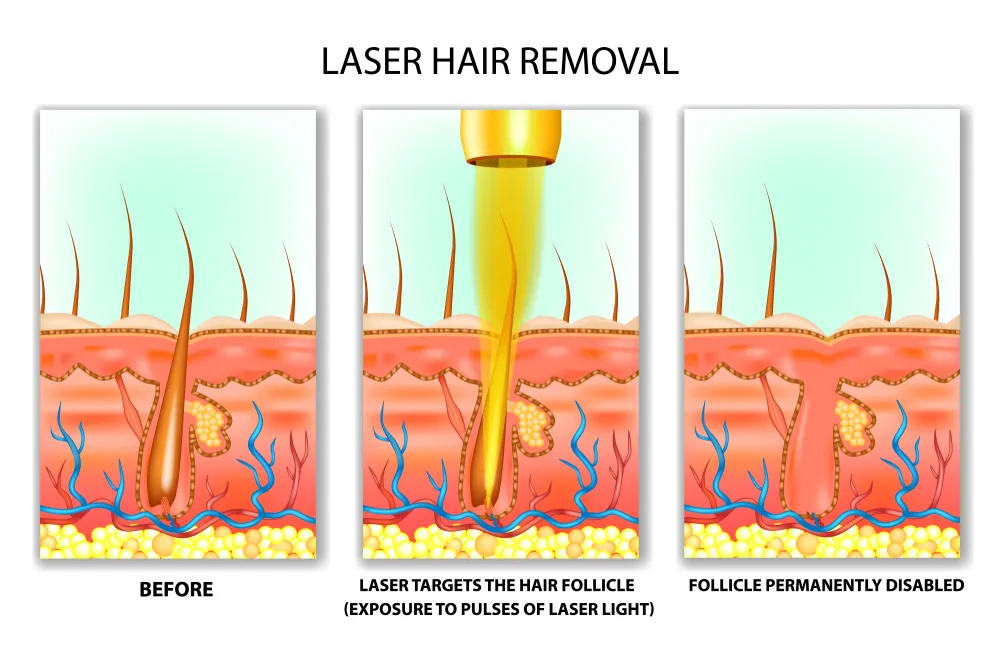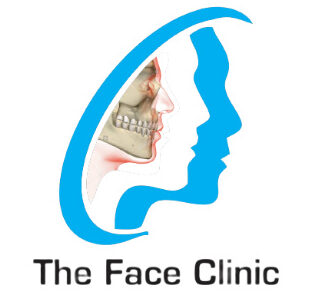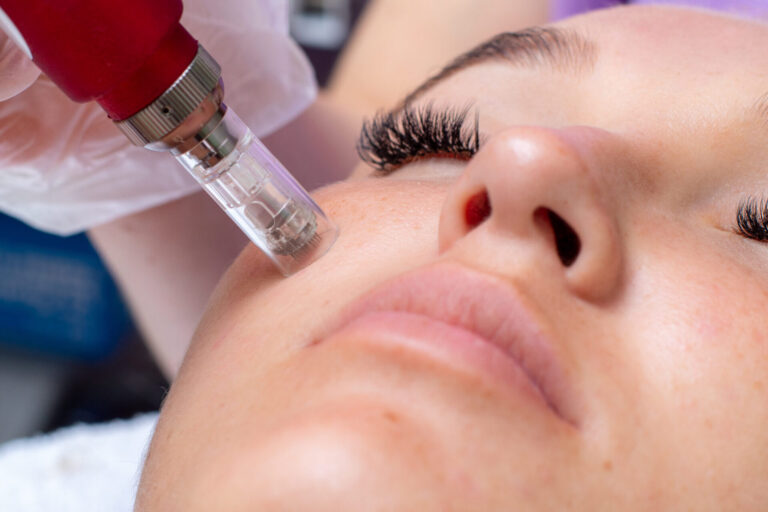Laser hair removal has revolutionized the beauty industry, offering a long-lasting solution to unwanted hair. Whether you’re tired of frequent shaving or dealing with the discomfort of waxing, laser hair removal provides a more permanent alternative. This guide covers everything you need to know about laser hair removal, from how it works to the benefits, risks, and essential preparation tips. Does it really stand among the top facial aesthetic treatments on planet?
What Is Laser Hair Removal?
Laser hair removal is a non-invasive cosmetic procedure that uses concentrated light beams (lasers) to remove unwanted hair. The laser targets hair follicles, emitting a pulse of energy that destroys them at their root. Over time, this reduces hair growth significantly, offering smoother skin without the hassle of constant upkeep.

Key Benefits of Laser Hair Removal
According to Cleveland Clinic latest research, laser hair removal outstand the benefits to risk ratio.
- Long-Lasting Results: Unlike shaving or waxing, laser hair removal reduces hair growth permanently after a series of sessions.
- Precision: The laser targets dark, coarse hair without damaging the surrounding skin.
- Time-Saving: Say goodbye to daily or weekly grooming routines.
Laser hair removal is suitable for most body areas, including the face, legs, arms, underarms, and bikini line.
Why Laser Hair Removal Is Gaining Popularity
In recent years, laser hair removal has become one of the most sought-after cosmetic treatments. Here’s why:
- Convenience: It eliminates the need for daily hair removal methods like shaving or time-consuming waxing appointments.
- Improved Technology: Advancements in laser technology have made treatments safer, faster, and more effective for a wider range of skin tones and hair types.
- Confidence Booster: Many people choose laser hair removal for its ability to deliver smooth, hair-free skin, boosting their confidence in various social and professional settings.
- Cost-Effective: Although the initial cost may seem high, laser hair removal often proves more economical over time compared to regular waxing or buying shaving supplies.
How Laser Hair Removal Works: The Science Explained
Laser hair removal is rooted in the science of selective photothermolysis, which involves matching a specific wavelength of light with pulse duration to target hair follicles. Here’s a step-by-step breakdown of how it works:
- Targeting Melanin: The laser emits a concentrated beam of light absorbed by the melanin (pigment) in the hair.
- Heat Generation: The light energy converts into heat, which damages the hair follicle.
- Inhibiting Growth: The heat disables the follicle, preventing future hair growth without harming the surrounding tissue.
Factors That Affect Effectiveness
- Hair Color and Thickness: Laser hair removal is most effective on dark, coarse hair.
- Skin Tone: Advanced lasers now accommodate a broader range of skin tones.
- Growth Cycle: Hair grows in cycles, and only hair in the active growth phase (anagen) can be effectively treated.

Benefits of Laser Hair Removal
Laser hair removal offers numerous advantages over traditional hair removal methods, making it one of the most popular cosmetic procedures worldwide. Let’s explore the key benefits that make it a preferred choice.
Long-Term Cost Savings vs. Other Hair Removal Methods
While the upfront cost of laser hair removal may seem high, it can save you money in the long run. Here’s how:
- Shaving Costs Add Up: Razors, shaving creams, and aftercare products quickly accumulate over time.
- Waxing Is Expensive: Regular waxing appointments can become a financial burden.
- Laser Hair Removal’s Longevity: Once you complete the recommended sessions, maintenance treatments are minimal, saving you money on repetitive expenses.
Precision and Effectiveness
Laser hair removal is renowned for its precision and ability to deliver consistent results:
- Targeted Treatment: The laser focuses on hair follicles without harming the surrounding skin, making it ideal for sensitive areas like the face and bikini line.
- Customizable for Different Areas: From large areas like the legs to small, intricate zones like the upper lip, laser technology adapts to various needs.
- Results You Can See: Patients often notice a significant reduction in hair growth after just a few sessions.
Reduced Hair Growth Over Time
One of the most appealing aspects of laser hair removal is its long-term impact on hair growth:
- Permanent Reduction: While not all hair is permanently removed, treated areas often see an 80–90% reduction in hair growth.
- Finer Regrowth: Any remaining hair is typically lighter, finer, and less noticeable.
- Fewer Maintenance Sessions: After completing the initial treatments, occasional touch-ups are all that’s needed to maintain smooth skin.
Pain Management: How Painful Is Laser Hair Removal?
Pain is one of the biggest concerns for first-time laser hair removal patients. However, the procedure is generally well-tolerated:
- Sensation Described: Most patients compare it to the snap of a rubber band or mild pinching.
- Pain Varies by Area: Areas with thicker skin, like the legs, tend to be less sensitive than thinner areas like the upper lip.
- Pain-Reduction Options:
- Numbing creams are often applied before the procedure.
- Advanced lasers come equipped with cooling systems to minimize discomfort.
Preparing for Laser Hair Removal
Proper preparation is crucial for a successful and safe laser hair removal experience. Follow these guidelines to ensure optimal results.
Pre-Treatment Checklist: Dos and Don’ts
Before undergoing laser hair removal, it’s important to prepare your skin and hair to maximize the procedure’s effectiveness and reduce side effects.
Shaving Before Treatment
- Why It’s Important: Shaving ensures the laser targets the hair follicle rather than burning the hair above the skin.
- Timing: Shave the treatment area 24–48 hours before your session.
- Avoid Waxing or Plucking: These methods remove the hair root, which is necessary for the laser to work effectively.
Avoiding Sun Exposure
- Protect Your Skin: Avoid direct sun exposure for at least two weeks before and after treatment to minimize the risk of burns or pigmentation changes.
- Use Sunscreen: Apply a broad-spectrum SPF 30 or higher on the treatment area if exposure to sunlight is unavoidable.

What to Expect During Your Consultation
Your consultation is an opportunity to discuss your goals, ask questions, and understand the process. Here’s what typically happens:
- Skin and Hair Assessment: The technician evaluates your skin tone and hair type to determine the best laser settings.
- Medical History Review: Disclose any medications, skin conditions, or recent sun exposure that could affect the procedure.
- Patch Test: A small area may be treated to ensure no adverse reactions and confirm the laser’s effectiveness.
Understanding Your Skin and Hair Type
The success of laser hair removal depends largely on your unique skin and hair characteristics. Here’s how it works:
Fitzpatrick Skin Types and Laser Suitability
- The Fitzpatrick scale categorizes skin types from I (very fair) to VI (very dark). This helps determine:
- The safest laser settings.
- The likelihood of pigmentation changes or burns.
- Advanced laser technologies like Nd:YAG are effective for darker skin tones, while Alexandrite lasers are better suited for lighter skin.
Laser Hair Removal Procedure
Understanding what happens during a laser hair removal session can help you feel more comfortable and prepared. This section walks you through every step, from what to expect during the procedure to managing discomfort and dealing with potential side effects.
What Happens During a Laser Hair Removal Session
A typical laser hair removal session involves the following steps:
- Preparation of the Treatment Area:
- The area is cleaned and shaved if necessary to remove any visible hair.
- A cooling gel or topical numbing cream may be applied to enhance comfort.
- Laser Application:
- The technician uses a handheld laser device to target hair follicles in the treatment area.
- The laser emits pulses of energy that penetrate the skin to reach the hair follicles, disabling their growth.
- Post-Treatment Care:
- After the procedure, soothing creams or aloe vera gel may be applied to reduce redness or irritation.
- The technician provides aftercare instructions tailored to your skin type and treatment area.
The process is straightforward and typically involves little to no downtime.
Duration of Each Session: Face, Arms, Legs, and Bikini Area
The length of a laser hair removal session varies depending on the size and location of the treatment area:
- Face (Upper Lip, Chin, or Cheeks): 10–15 minutes
- Arms: 20–30 minutes
- Legs (Full): 45 minutes to 1 hour
- Bikini Area: 20–30 minutes
- Underarms: 10–15 minutes
Smaller areas like the upper lip are quick to treat, while larger areas like the legs may require more time.
Pain Management During the Procedure
Although laser hair removal is generally well-tolerated, some patients may experience mild discomfort. Here are ways to manage it:
Numbing Creams:
- How They Work: Numbing creams are applied 30–60 minutes before the procedure to desensitize the skin.
- Availability: Many clinics provide numbing creams upon request, or you can purchase them over-the-counter.
Cooling Devices and Techniques:
- Built-In Cooling Systems: Modern lasers often have cooling mechanisms to minimize heat and discomfort during treatment.
- Cold Compress: Applying a cold compress to the area immediately before and after treatment can help reduce sensitivity.
Other Alternatives:
- Over-the-counter pain relievers (e.g., ibuprofen) may be taken before the session.
- Relaxation techniques, such as deep breathing, can help ease tension during the procedure.
Common Side Effects During and After Treatment
Laser hair removal is generally safe, but some temporary side effects may occur. Here’s what you can expect and how to manage them:
Redness and Swelling:
- Cause: The laser’s heat can cause mild irritation in the treated area.
- Management: Apply aloe vera gel or a soothing cream to calm the skin.
Sensitivity or Mild Discomfort:
- Cause: The heat generated during the procedure can make the skin feel slightly tender.
- Management: Avoid hot showers, saunas, or strenuous activities for 24–48 hours after treatment.
Temporary Pigmentation Changes:
- Hyperpigmentation: Dark spots may appear on lighter skin.
- Hypopigmentation: Lighter spots may appear on darker skin.
- Resolution: These changes are usually temporary and fade over time.
Rare Side Effects:
- Blistering or Burns: Rare with experienced technicians but can occur if the wrong settings are used.
- Hair Growth Stimulation: In rare cases, fine hairs may grow in untreated areas near the treatment site.
Tips to Minimize Side Effects:
- Follow all aftercare instructions provided by your technician.
- Avoid sun exposure and use sunscreen with at least SPF 30 on treated areas.
- Keep the area clean and moisturized.
Post-Treatment Care and Recovery
Proper post-treatment care is essential for ensuring the best results from laser hair removal while minimizing discomfort and potential side effects. This section outlines immediate aftercare steps, long-term skincare tips, and strategies to manage common side effects like redness, swelling, and pigmentation changes.
Immediate Aftercare Steps
After a laser hair removal session, your skin will be more sensitive, so it’s crucial to follow these immediate care instructions:
- Apply Cooling Agents:
- Use aloe vera gel or a soothing cream recommended by your technician to calm any redness or irritation.
- Cold compresses can also help reduce heat in the treated area.
- Avoid Heat:
- Stay away from hot showers, saunas, or steam rooms for at least 48 hours to prevent further irritation.
- Refrain from using heated beauty tools (e.g., hot wax or facial steamers) on the treated area.
- Protect Your Skin from the Sun:
- The treated skin is more prone to sunburn and pigmentation issues. Apply a broad-spectrum sunscreen with SPF 30 or higher if you need to be outdoors.
- Wear protective clothing over treated areas for added protection.
- Skip Makeup and Harsh Products:
- Avoid applying makeup, perfumes, or any products containing alcohol, retinoids, or exfoliants on the treated area for at least 24–48 hours.
- Avoid Physical Activities:
- Refrain from strenuous exercise or activities that cause sweating, as sweat can irritate the treated skin and lead to infections.
Long-Term Skincare for Treated Areas
Once the initial sensitivity subsides, adopting a long-term skincare routine will help maintain the results of your laser hair removal treatment:
- Moisturize Regularly:
- Keep the treated area hydrated with a gentle, fragrance-free moisturizer to maintain skin health and elasticity.
- Exfoliate Gently:
- About a week after treatment, you can begin gently exfoliating the area to help shed dead hair follicles and prevent ingrown hairs. Use a mild scrub or exfoliating glove once or twice a week.
- Stay Consistent with Sunscreen:
- Continue using sunscreen daily on treated areas, as prolonged UV exposure can lead to pigmentation changes and skin damage.
- Avoid Tanning:
- Both natural tanning and tanning beds can increase the risk of burns and pigmentation issues after laser treatment.
- Plan Maintenance Sessions:
- Follow your technician’s recommendations for maintenance sessions to prolong the hair-free results. Typically, touch-ups are needed once or twice a year.
How to Manage and Prevent Side Effects
Though laser hair removal is safe, some side effects may occur. Here’s how to manage and minimize them:
Redness
- Why It Happens: The laser’s heat causes temporary irritation in the treated area.
- How to Manage It:
- Apply a cold compress immediately after the session to soothe the skin.
- Use over-the-counter hydrocortisone cream to reduce redness and inflammation.
- Prevention Tips:
- Avoid touching or scratching the treated area.
- Follow aftercare instructions strictly to prevent prolonged irritation.
Swelling
- Why It Happens: Swelling is a common reaction to the laser’s impact on hair follicles.
- How to Manage It:
- Use ice packs or cold compresses to reduce swelling.
- Elevate the treated area if possible (e.g., legs) to decrease fluid retention.
- Prevention Tips:
- Avoid activities that promote blood flow to the treated area, such as exercise or hot showers.
Pigmentation Changes
- Why It Happens:
- Hyperpigmentation: Dark spots may appear due to increased melanin production from laser exposure.
- Hypopigmentation: Lighter spots may appear if melanin production is reduced.
- How to Manage It:
- Apply skin-brightening creams or serums (under the guidance of a dermatologist) for hyperpigmentation.
- Use moisturizers and gentle skincare products to support skin recovery.
- Prevention Tips:
- Always use sunscreen on the treated area, even on cloudy days.
- Avoid tanning and excessive sun exposure for at least 2–4 weeks post-treatment.
Effectiveness and Results of Laser Hair Removal
Laser hair removal is a widely utilized method for reducing unwanted hair, offering long-term results compared to traditional hair removal techniques. Its effectiveness can vary based on several factors, including the number of sessions, individual characteristics, and the areas treated. This section delves into these aspects, referencing scientific studies to provide a comprehensive understanding.
How Many Sessions Are Required for Optimal Results?
The number of laser hair removal sessions needed for optimal results varies among individuals. Generally, multiple treatments are necessary to achieve significant hair reduction. A study published in the Journal of Clinical and Aesthetic Dermatology indicates that most patients require 6 to 8 sessions, spaced 4 to 6 weeks apart, to achieve satisfactory results. This schedule aligns with the hair growth cycle, ensuring that the laser targets hairs in the active growth phase (anagen) for maximum efficacy.
What Affects the Results of Laser Hair Removal?
The effectiveness of laser hair removal is influenced by several factors, including hair color and texture, as well as hormonal influences.
Hair Color and Texture
Laser hair removal works by targeting melanin, the pigment in hair follicles. Therefore, individuals with dark, coarse hair and light skin typically experience the most effective results. Conversely, those with light-colored hair (blonde, red, gray) may see less pronounced outcomes due to the lower melanin content. Advancements in laser technology have improved efficacy for a broader range of hair and skin types, but challenges remain for certain combinations.
Hormonal Factors
Hormonal imbalances can significantly impact hair growth patterns and, consequently, the effectiveness of laser hair removal. Conditions such as polycystic ovary syndrome (PCOS) can lead to increased hair growth, potentially necessitating additional treatment sessions to achieve desired results. A review in the International Journal of Women’s Dermatology emphasizes the importance of addressing underlying hormonal issues to enhance the efficacy of laser hair removal treatments.
What Areas of the Body Can Be Treated?
Laser hair removal is versatile and can be applied to various body areas, including:
- Face: Upper lip, chin, sideburns
- Upper Body: Underarms, arms, chest, back
- Lower Body: Bikini line, legs
The suitability and effectiveness of treatment can vary based on skin sensitivity and hair characteristics in these areas. Consulting with a qualified practitioner is essential to determine the best treatment plan for each specific area.

Can Laser Hair Removal Provide Permanent Results?
While laser hair removal significantly reduces hair growth, it does not guarantee complete and permanent hair removal. The U.S. Food and Drug Administration (FDA) classifies the procedure as providing permanent hair reduction, meaning it can reduce the number of regrowing hairs by a significant percentage over the long term. Maintenance sessions may be required to address any regrowth, which is typically finer and lighter than the original hair.
In conclusion, laser hair removal offers a substantial reduction in hair growth, with the degree of effectiveness influenced by factors such as the number of sessions, hair characteristics, hormonal factors, and the specific areas treated. Consulting with a qualified professional can provide personalized insights and optimize treatment outcomes.
Risks and Considerations of Laser Hair Removal
Although laser hair removal is generally considered safe and effective, it’s important to understand its limitations and risks. Certain individuals may not be ideal candidates, and there are potential side effects to consider. This section breaks down who is suitable for the procedure, the risks involved, and common myths versus facts about laser hair removal.
Who Is Not Suitable for Laser Hair Removal?
While laser hair removal is widely available, some individuals may not be good candidates due to specific health or skin conditions.
Pregnant Women
- Why It’s Not Recommended: Although no definitive studies show laser hair removal is harmful during pregnancy, most medical professionals advise against it as a precaution. Hormonal changes during pregnancy can also affect skin sensitivity and pigmentation, increasing the risk of side effects.
- Alternative Solutions: Temporary methods like shaving or trimming are safer options during pregnancy.
Certain Skin Conditions
- Photosensitive Disorders: Individuals with conditions like lupus or taking medications that cause photosensitivity (e.g., certain antibiotics, retinoids) are at higher risk of burns or irritation.
- Active Skin Issues: Those with open wounds, infections, or inflammatory skin conditions (e.g., eczema, psoriasis) in the treatment area should wait until their skin heals.
- Tattoos and Permanent Makeup: Laser hair removal is not advised over tattooed areas as the laser can damage the tattoo and surrounding skin.
Potential Risks and Complications
Though complications are rare when performed by trained professionals, it’s important to be aware of the possible risks.
Burns
- Cause: Burns can occur if the laser’s settings are inappropriate for the individual’s skin type.
- Prevention: Choose a certified and experienced practitioner who conducts a patch test before the procedure. Avoid sun exposure before the session.
Hyperpigmentation and Hypopigmentation
- Hyperpigmentation: This involves dark spots appearing on the skin post-treatment, often due to increased melanin production triggered by the laser.
- Hypopigmentation: In contrast, lighter spots may develop due to reduced melanin. This is more common in individuals with darker skin tones if incorrect laser settings are used.
- Prevention and Management: Always use sunscreen post-treatment and follow aftercare instructions. If pigmentation changes occur, consult a dermatologist for topical treatments.
Other Rare Side Effects
- Blisters or Scarring: Extremely rare but possible if the skin is excessively sensitive or the technician lacks experience.
- Hair Growth Stimulation: In rare cases, laser treatment may stimulate fine hair growth in untreated areas near the treatment site.
Myths vs. Facts About Laser Hair Removal
With the popularity of laser hair removal, several myths circulate about its effectiveness and safety. Let’s separate fact from fiction:
Myth: Laser hair removal works the same for everyone.
Fact: The procedure’s effectiveness depends on skin tone, hair color, and texture. People with light skin and dark hair often see the best results, although advanced lasers are now effective for diverse skin types.
Myth: Laser hair removal is completely permanent.
Fact: While laser hair removal significantly reduces hair growth, maintenance sessions are often required to address new hair growth or fine regrowth.
Myth: It’s unsafe for darker skin tones.
Fact: Older laser technologies posed risks for darker skin tones, but newer systems like the Nd:YAG laser are safe and effective for all skin types when handled by experienced professionals.
Myth: It’s a painful procedure.
Fact: Most people describe the sensation as similar to a rubber band snapping against the skin. Cooling systems and numbing creams are available to minimize discomfort.
Myth: Laser hair removal causes cancer.
Fact: No scientific evidence links laser hair removal to cancer. The lasers used target hair follicles and do not penetrate deep enough to affect internal tissues or organs.
Comparing Laser Hair Removal with Other Methods
When deciding on the best hair removal method, it’s essential to weigh the benefits, drawbacks, and long-term results of each. Laser hair removal stands out for its long-term effectiveness, but how does it compare to other methods like waxing, electrolysis, shaving, and IPL? Here’s an in-depth comparison.
Laser Hair Removal vs. Waxing
Waxing Pros:
- Immediate Results: Waxing provides smooth, hair-free skin instantly.
- Accessible: It’s widely available and can be done at home or by professionals.
- Suitable for All Hair Types: Works on fine, thick, or light hair.
Waxing Cons:
- Painful: Many people find waxing to be uncomfortable, especially in sensitive areas.
- Temporary Results: Hair regrowth occurs in about 3–6 weeks.
- Skin Irritation: Can cause redness, ingrown hairs, and irritation.
Laser Hair Removal Pros:
- Long-Term Reduction: Offers permanent hair reduction after multiple sessions.
- Less Frequent Maintenance: After initial treatments, touch-ups are needed only once or twice a year.
- Reduced Ingrown Hairs: Unlike waxing, laser hair removal minimizes the risk of ingrown hairs.
Laser Hair Removal Cons:
- Higher Upfront Cost: More expensive than waxing initially.
- Not Instantaneous: Results take time, as multiple sessions are required.
Verdict: Laser hair removal is a better long-term investment, while waxing is ideal for temporary and immediate results.
Laser Hair Removal vs. Electrolysis
Electrolysis Pros:
- Permanent Hair Removal: Approved by the FDA as a permanent solution.
- Universal Effectiveness: Works on all hair types and colors.
Electrolysis Cons:
- Time-Consuming: Each hair follicle is treated individually, making it a lengthy process.
- Painful: Many describe electrolysis as more painful than laser treatments.
- Skin Irritation: Temporary redness, swelling, or scarring can occur.
Laser Hair Removal Pros:
- Faster Treatment: Large areas like the legs or back can be treated quickly.
- Comfortable: Generally less painful than electrolysis.
- Advanced Technology: Effective for a range of skin tones and hair types, though lighter hair may require additional sessions.
Laser Hair Removal Cons:
- Not Always Permanent: Offers long-term reduction rather than guaranteed permanent removal.
- Limited Effectiveness on Light Hair: Less effective for blonde, red, or gray hair.
Verdict: Electrolysis is best for those seeking permanent removal of small areas, while laser hair removal is preferable for larger areas and long-term reduction.
Laser Hair Removal vs. Shaving and Epilators
Shaving Pros:
- Quick and Painless: Shaving is easy, non-invasive, and painless.
- Inexpensive: Requires minimal investment in razors and shaving cream.
- Convenient: Can be done at home anytime.
Shaving Cons:
- Temporary Results: Hair regrows within a few days.
- Skin Irritation: Can cause razor burns, cuts, or ingrown hairs.
- Time-Consuming: Requires frequent upkeep.
Epilators Pros:
- Cost-Effective: A one-time investment with long-term use.
- Longer Results Than Shaving: Hair regrowth takes a few weeks.
- Suitable for All Hair Types: Works on fine or coarse hair.
Epilators Cons:
- Painful: Hair removal with epilators can be quite uncomfortable.
- Not Suitable for Large Areas: Using an epilator on large areas like legs can be time-consuming.
- Ingrown Hairs: Similar to shaving, epilators can cause ingrown hairs.
Laser Hair Removal Pros:
- Long-Lasting Results: Reduces hair growth permanently after multiple sessions.
- Smoother Skin: Avoids irritation and cuts caused by shaving or epilators.
Laser Hair Removal Cons:
- Initial Cost: More expensive than shaving or epilators.
- Requires Professional Supervision: DIY options are available but less effective.
Verdict: Shaving and epilators are suitable for short-term results, while laser hair removal is ideal for long-term convenience and smooth skin.
IPL vs. Laser Hair Removal: Which Is Better?
IPL (Intense Pulsed Light) Pros:
- Cost-Effective: IPL devices are often less expensive than professional laser treatments.
- At-Home Options: Many IPL devices are available for home use.
- Good for Light Hair: Can sometimes treat lighter hair better than laser.
IPL Cons:
- Less Effective on Dark Skin: IPL devices are less precise and pose a higher risk for darker skin tones.
- Slower Results: More sessions are typically needed to achieve similar results to laser.
- Limited Penetration: Does not penetrate as deeply as laser, reducing its efficacy on thick or coarse hair.
Laser Hair Removal Pros:
- Precise Targeting: Lasers focus on hair follicles, making them more effective for thick or coarse hair.
- Faster Results: Fewer sessions are required compared to IPL.
- Suitable for All Skin Types: Modern laser systems can treat a wide range of skin tones safely.
Laser Hair Removal Cons:
- Cost: Professional laser treatments can be more expensive than IPL devices.
- Requires Professional Expertise: DIY laser devices are not as powerful as those used by professionals.
Verdict: Laser hair removal is the better choice for faster, more precise, and long-lasting results, while IPL is a budget-friendly option for at-home treatments with moderate results.
Cost and Accessibility
Laser hair removal’s cost and accessibility are key factors for many considering the procedure. Here’s a breakdown of what you can expect, including regional price differences, the value of at-home devices, and financing options.
Average Costs of Laser Hair Removal in Different Regions
The cost of laser hair removal varies depending on the treatment area, location, and clinic. Here are average price ranges for popular treatment areas:
- Face (Upper Lip or Chin): $100–$300 per session
- Underarms: $150–$250 per session
- Bikini Line: $200–$400 per session
- Legs (Full): $500–$800 per session
Regional Factors:
- Urban Areas: Clinics in metropolitan areas tend to charge more due to higher demand and operational costs.
- International Costs: For instance, treatments in the U.S. are often more expensive than in Europe or Asia, where medical tourism can reduce costs.
Are At-Home Laser Devices Worth It?
At-home laser and IPL devices have gained popularity for their convenience and affordability. Here’s a look at their benefits and drawbacks:
Benefits:
- Cost-Effective: At-home devices typically range from $300–$600, making them a one-time investment.
- Convenience: You can perform treatments on your own schedule without traveling to a clinic.
- Safe for Small Areas: Effective for touch-ups on smaller body areas like the face or underarms.
Drawbacks:
- Less Powerful: At-home devices are less effective than professional treatments, requiring more sessions for comparable results.
- Limited Suitability: Not ideal for darker skin tones or lighter hair due to safety concerns and reduced efficacy.
- Time-Consuming: Treating large areas like the legs can be tedious.
Verdict: At-home devices are worth considering for maintenance or minor treatments, but professional laser hair removal remains the gold standard for significant hair reduction.
Insurance and Financing Options for Laser Hair Removal
Laser hair removal is considered a cosmetic procedure, meaning it’s typically not covered by insurance. However, there are financing options available:
- Payment Plans: Many clinics offer installment plans to spread out the cost over several months.
- Membership Discounts: Some clinics provide packages or memberships that reduce per-session costs.
- Medical Savings Accounts (HSA/FSA): Depending on your provider, you may use these accounts to cover laser hair removal if deemed medically necessary (e.g., for a condition like hirsutism).
Innovations and Trends in Laser Hair Removal
The field of laser hair removal continues to evolve, with new technologies and techniques enhancing its safety, effectiveness, and accessibility.
Advances in Laser Technology
- Multiple Wavelength Lasers: Modern devices, like the Candela GentleMax Pro, combine different laser wavelengths (e.g., Alexandrite and Nd:YAG) to treat diverse skin tones effectively.
- Pain-Reduction Features: Innovations such as cooling systems and air-based pain relievers improve patient comfort.
- Faster Treatment Times: Advanced lasers cover larger areas in less time, reducing session durations significantly.
Customization Based on Skin Tone and Hair Type
- Tailored Settings: Newer lasers can adjust parameters like wavelength and pulse duration to accommodate individual needs.
- Safe for Darker Skin Tones: Technologies like Nd:YAG lasers safely treat darker skin by bypassing melanin in the skin’s surface.
Integration with AI for Precision
Artificial intelligence (AI) is now being integrated into laser devices to enhance precision and outcomes:
- Smart Sensors: AI-powered lasers detect skin tone and hair density in real time, automatically adjusting settings for optimal results.
- Data Tracking: Clinics use AI to monitor patient progress, ensuring consistent improvement over multiple sessions.
Real Stories and Testimonials
Hearing real experiences from individuals who have undergone laser hair removal can provide valuable insights into what to expect, from successful outcomes to common challenges.
Case Studies of Successful Treatments
Case Study 1: Long-Term Hair Reduction
- Patient Profile: A 29-year-old woman with fair skin and dark hair opted for laser hair removal on her legs and underarms.
- Results: After 6 sessions over 6 months, she achieved an 85% reduction in hair growth. She now requires only annual touch-up treatments.
- Key Takeaway: Her consistent adherence to the treatment schedule and aftercare regimen contributed to her success.
Case Study 2: Managing Hormonal Hair Growth
- Patient Profile: A 35-year-old woman with PCOS struggled with excess facial hair.
- Results: With 8 sessions targeting her upper lip and chin, she saw a significant reduction in hair thickness and regrowth.
- Key Takeaway: Though additional sessions were needed due to hormonal factors, the treatment improved her confidence and reduced the need for frequent shaving.
Case Study 3: Treating Dark Skin Safely
- Patient Profile: A 40-year-old man with dark skin underwent laser hair removal on his chest and back.
- Results: Using Nd:YAG technology, he completed 7 sessions with minimal side effects and achieved a 75% reduction in hair.
- Key Takeaway: Choosing the right laser for his skin tone was critical in avoiding burns and pigmentation changes.
12.2 Common Challenges People Face
Challenge 1: Patchy Results After Initial Sessions
- Cause: Hair grows in cycles, and not all follicles are in the active (anagen) phase during a session.
- Solution: Patience is key; results become more consistent with additional treatments.
Challenge 2: Temporary Side Effects
- Examples: Redness, swelling, or mild irritation are common immediately after treatment.
- Solution: Following aftercare instructions, such as applying soothing creams and avoiding sun exposure, helps minimize these effects.
Challenge 3: Managing Expectations
- Reality: Laser hair removal reduces hair growth significantly but may not eliminate it entirely.
- Solution: Discuss realistic goals with your provider during the consultation.
13. Choosing the Right Laser Hair Removal Clinic
Selecting the right clinic is critical to ensuring safe and effective results. Here’s what to consider:
13.1 Factors to Consider: Expertise, Equipment, and Reviews
Expertise:
- Experience Matters: Look for clinics with certified and experienced technicians.
- Specialization: Choose a clinic that focuses on laser treatments, as opposed to one offering a wide range of unrelated services.
Equipment:
- Modern Technology: Ensure the clinic uses FDA-approved lasers suitable for your skin tone and hair type (e.g., Alexandrite, Nd:YAG).
- Maintenance: Ask about the clinic’s equipment maintenance to ensure safety and effectiveness.
Reviews:
- Online Feedback: Check reviews on Google, Yelp, or specialized platforms.
- Word of Mouth: Ask friends or family for recommendations if they’ve had successful treatments.
Importance of a Patch Test Before the Procedure
A patch test is a small trial run on a discreet area of skin to determine how your skin reacts to the laser. It’s a crucial step for safety and effectiveness.
Why It’s Essential:
- Safety Check: Identifies any adverse reactions, such as excessive redness or blistering.
- Optimized Settings: Helps the technician determine the ideal laser intensity and wavelength for your skin and hair type.
What to Expect:
- The technician applies the laser to a small area, and you monitor the skin’s reaction over 24–48 hours.
- If no significant irritation occurs, you’re likely a good candidate for the procedure.
Conclusion
Laser hair removal offers a transformative solution for those seeking long-term freedom from unwanted hair. It’s a safe, effective, and convenient method that delivers smoother skin and reduces the hassle of frequent hair removal routines like shaving, waxing, or epilating. Key benefits include:
- Long-Term Results: Significant and lasting hair reduction after a series of sessions.
- Precision and Safety: Advanced lasers target hair follicles without damaging surrounding skin.
- Time and Cost Savings: Reduced dependency on traditional hair removal methods saves time and money over the years.
- Improved Confidence: Smooth, hair-free skin enhances comfort and self-esteem in daily life.
This procedure has evolved to be accessible for a variety of skin tones and hair types, making it a versatile choice for men and women alike.
Encouragement to Consult a Specialist
While laser hair removal offers incredible benefits, it’s important to approach the procedure with the right knowledge and guidance. Consulting a certified specialist ensures:
- Personalized Advice: Your technician can tailor the treatment to your specific skin type, hair texture, and desired outcomes.
- Safety: A trained professional minimizes the risk of side effects through proper laser selection and application.
- Realistic Expectations: An expert can help you understand what results to expect and how to achieve the best outcome.
Your consultation is the first step toward a successful and satisfying hair removal journey.
Final Words on Embracing Hair-Free Confidence
Embarking on the laser hair removal journey is about more than just eliminating hair—it’s about embracing your confidence and freeing yourself from the hassles of constant grooming. Whether it’s for smoother skin, reduced irritation, or the joy of low-maintenance beauty, laser hair removal can be life-changing.
By choosing the right aesthetic clinic, understanding the process, and committing to proper aftercare, you’re investing in a solution that offers both convenience and lasting results. Take the next step and explore the possibilities of laser hair removal. Your journey to hair-free confidence begins now!
Frequently Asked Questions (FAQs)
11.1 Is Laser Hair Removal Safe for All Skin Types?
Yes, modern lasers like the Nd:YAG are safe for all skin types, from light to dark. However, those with very light hair or conditions like vitiligo should consult a dermatologist for personalized advice.
11.2 Can Men Undergo Laser Hair Removal?
Absolutely! Laser hair removal is increasingly popular among men for areas like the chest, back, and beard line. It’s an effective solution for reducing ingrown hairs caused by shaving.
11.3 How Soon Can I See Results?
Most patients notice a reduction in hair growth after the first session. Significant results typically appear after 3–4 sessions, with optimal outcomes achieved after completing the recommended series of treatments.
11.4 Can Laser Hair Removal Be Done on Tattoos?
No, laser hair removal should not be performed over tattooed areas. The laser can interact with the tattoo’s pigment, potentially causing burns or altering the tattoo’s appearance. Special care is taken to avoid tattooed areas during treatm







One Comment
Comments are closed.